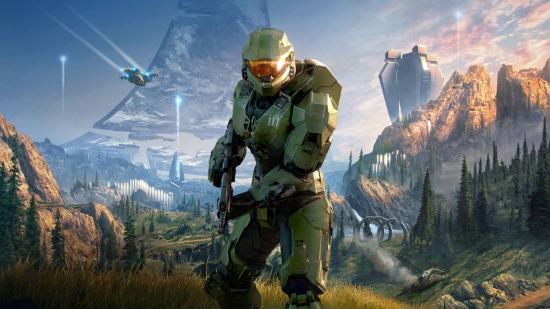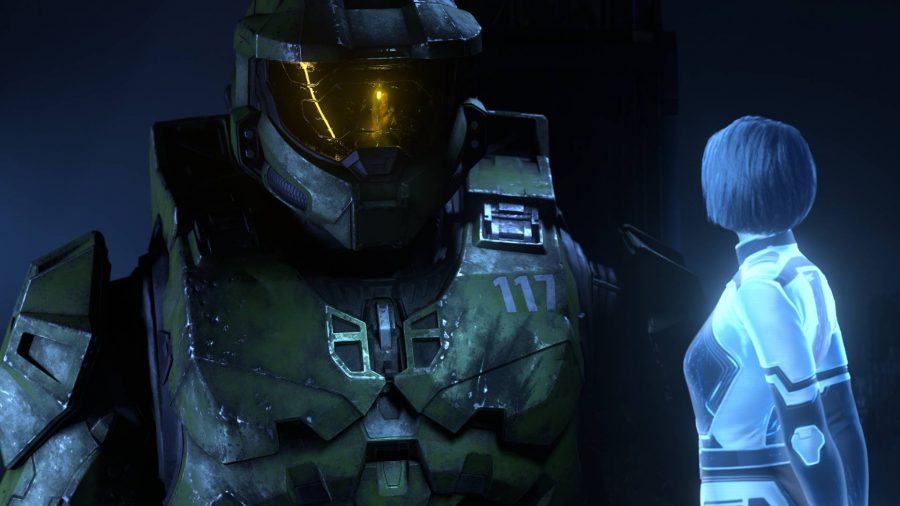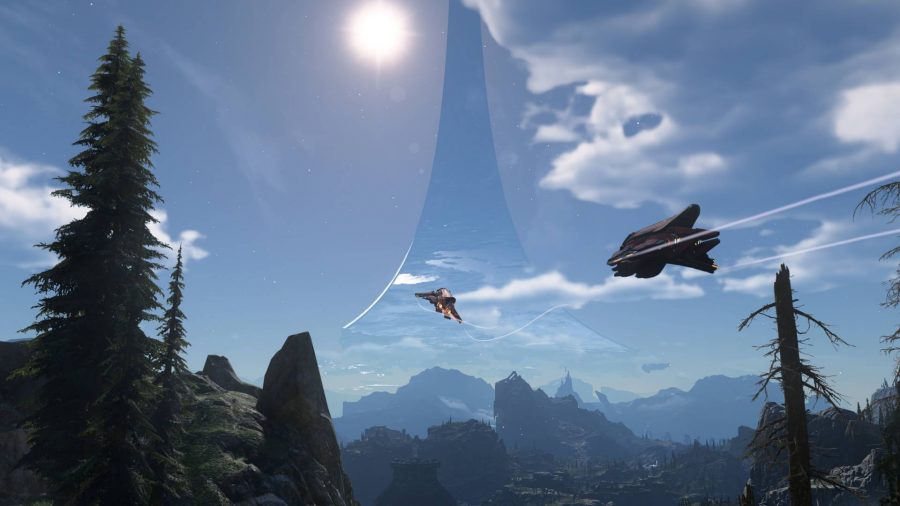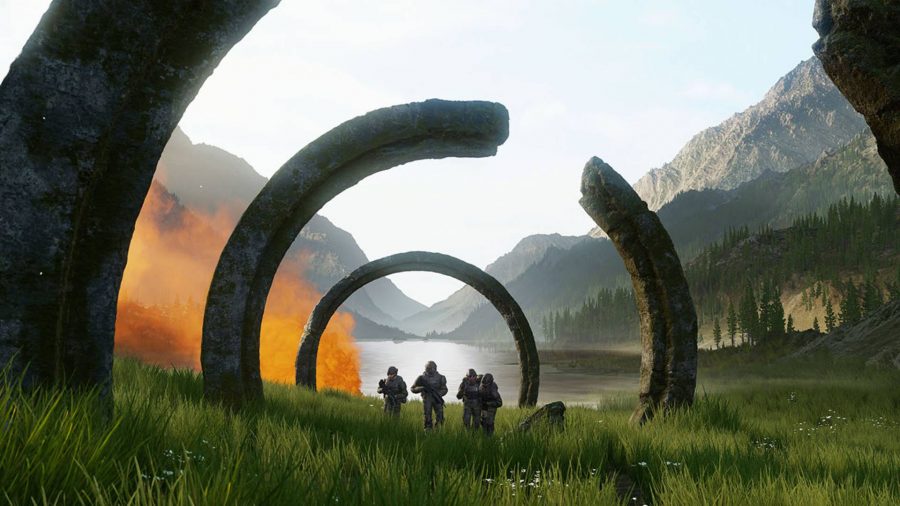Our Verdict
Halo Infinite offers the full Master Chief experience in a big, beautiful sandbox. While 343 may not be breaking new ground with the light open-world elements it has added, it has done a great job of creating a solid experience for new and returning players alike.
Surrounded by a battalion of Banished, Master Chief knows that his Mjolnir armor is going to come in handy. With nothing but a single MK50 Sidekick round to his name, the stoic Spartan plants one between the eyes of the nearest Grunt, before using his shiny new grappleshot attachment to fish up his now-deceased target’s Needler.
With military precision, Chief proceeds to provide his acupuncture services to an oncoming Brute, discarding the spent handgun for a Mangler and a couple of grenades. To the Chief, the transaction is like trading a penny for a stick of gum, except now he’s trading two grenades for several kills and a SPNKr rocket launcher.
By this point the enemy’s morale is broken, with Grunts and Jackals alike beginning to flail around in horror. The music swells, everything is exploding, and yet Chief remains as cool as a cucumber-coloured Spartan can, finessing his way through the remaining combatants. Damn it feels good to be a seven-foot armored supersoldier.
Truly, the skirmish-fuelled, scavenging-heavy style of combat Halo has long championed feels better than ever in Halo Infinite – it definitely feels like developer 343 Industries’ love letter to the iconic franchise’s roots.
But while Infinite draws heavily on the games which defined the series, more significantly, Halo Infinite also represents 343’s attempt to distance itself from its predecessors.
Referred to by 343 head Bonnie Ross as a “spiritual reboot”, Halo Infinite does away with much of what was left over by the end of Halo 5: Guardians. Set in May 2560, there’s no Locke, no Arbiter, no Halsey, and most notably no Cortana in sight as you jump in for the first time. This time, it’s all Chief, with 343 giving him all the space he needs to deploy his particular set of skills.
As Halo Infinite opens all we see is the lone Spartan Master Chief floating through space following a lost battle, before being picked up by the pilot of the Pelican ship Echo 216. The pilot had also been left adrift for some time after the conflict, accompanied only by a recording of his family which serves as his driving motivation to get home. It’s quickly revealed that the pair are just off of Zeta Halo – the seventh and final remaining ring from the original Halo array.
After marauding his way back into Installation 07, Chief is reunited with his new AI companion for this adventure, the Weapon, who informs him that Cortana had been deleted before she could lock her down for retrieval. However, for some reason, the Weapon’s own self-deletion protocol failed to kick in, leaving her hooked up to the system.
Upon taking the Weapon back, your merry trio of primary protagonists is complete. Indeed, Halo Infinite is very much an intimate adventure, with the destinies of all three characters inextricably linked.
At times dialogue is littered with banter, while at others it is marred by disputes as their motivations collide, and their trust is tested throughout the ten-or-so-hour campaign. This is epitomised by the disconnect between Chief’s mission to find out what happened to Cortana, and the pilot’s desperation to get back to his family.
With the Weapon continually prying into Chief’s complex relationship with Cortana, and the pilot providing a contrast point between the human and the superhuman, the conditions are perfect for us to learn a whole lot more about who the Master Chief really is – and this is explored excellently throughout Infinite’s campaign structure, too.
Early on we’re also introduced to a trio of antagonists, one of whom Halo Wars 2 players will remember in Atriox, leader of the Banished, though he appears to be MIA. Infinite does a solid job of explaining his motivations within its narrative, so new players won’t have to acquaint themselves with the Brute warchief beforehand.
Unlike other Covenant splinter factions like Jul ‘Mdama’s in Halo 5, the Banished appear to be on a completely different level thanks to the ferocity of its leadership. Alongside Atriox is his mentor, Escharum, as well as the mysterious Harbinger.
With the stage for Chief’s latest adventure set, and its more linear opening passages passed, Chief finally steps out onto Outpost Tremonius, introducing us to Zeta Halo’s lush overworld.
That claustrophobic feeling of being crammed into tight corridors with a boatload of Banished is instantly washed away as you gaze up into its skybox for the very first time, taking it all in with a sense of awe as I’m sure many Halo: Combat Evolved players can remember doing when they took their first steps on Alpha Halo some 20 years ago.
While Halo Infinite won’t quite let you explore the full 10,000 kilometre radius that remains of Zeta Halo, what you do get is a beautiful wide open landscape to explore, with a subtle injection of linearity that doesn’t feel restraining – note that I haven’t called it ‘open world’, and we’ll come back to why shortly.
Before you get a chance to really gorge yourself on Halo Infinite’s stunning vistas, you’re rudely interrupted by yet another band of Banished. As it transpires, what was once a UNSC base is now home to the blighters – we can’t be having that now. Once Tremonius is liberated, Chief’s secondary focus to re-establish a UNSC presence on Halo Installation 07 becomes clear.
For much of Halo Infinite’s campaign you’ll find yourself juggling two main missions: figuring out what happened to Cortana, and clearing out the Banished on the ring – from small pockets to entire bases teeming with them. Initially, you’re a one man army taking on skirmish after skirmish, but in time Chief is joined by UNSC marines after making space for them to deploy to recaptured Forward Operating Bases, or ‘FOBs’.
While swinging from every piece of remotely vertical terrain using the Grappleshot – an inspired addition to the Chief’s toy box – is rather good fun, having fast travel access to FOBs and other major POIs on the map is certainly welcomed. What’s more, you can deploy vehicles like the Mongoose, Scorpion, and even a WASP, once you’ve accumulated enough Valor – a currency earned through completing certain activities on Zeta Halo – making traversing the map and gaining extra firepower a breeze.
However, for all you collectible hunters out there, you won’t be able to go from corner to corner searching for all the Halo Infinite skull locations at once. You see, 343 has done a wonderful job of creating the illusion of an open world, achieved by the studio chopping the map up into different quest-gated zones. Progressing through the plot in one area will unlock the next, and so on and so forth.
For players like myself who are easily overwhelmed when the entire overworld is lit up for miles around with stuff to do (see: Horizon Zero Dawn), 343 tempers the experience within these cordoned-off yet meaty sandboxes.
Icons showing collectible locations won’t appear without clearing its corresponding FOB, allowing you to go and clear through content in bitesize chunks if you so wish. If on the other hand you just want to blitz through and reveal (almost) everything each area has to offer, you are more than free to do so.
343 has definitely been hard at work filling each area with plenty of side content. Alongside collectibles to hunt for, you’ll also happen upon upgrade components for your Mjolnir armor called Spartan Cores, as well as bounty locations for wanted Banished leaders and a number of larger Banished strongholds to conquer.
To be honest, I found that most of the Mjolnir upgrades for Chief’s equipment (aside from the Grappleshot) weren’t necessary until you really cranked up the difficulty, though on those higher difficulties they are arguably worth taking the time to hunt the cores for.
As for the bounty bosses, well, they weren’t particularly difficult, and the only ones which did provide a challenge were those who were kitted with either massive amounts of health, or a power weapon that could kill you in one shot. The lack of mechanical variety is definitely a factor in this imbalance, and it’s an issue which persists across a number of Infinite’s larger encounters.
While you don’t have the option to plan any detailed assaults on Banished strongholds from FOBs, you can at least bring a few marines along with you in your vehicle of choice should you go on the offensive. The AI is solid for the most part, and can absolutely beam down foes with an accuracy akin to those fresh Call of Duty: Warzone accounts with suspiciously-high K/DRs.
The enemy AI meanwhile remains as consistent as ever, with Banished combatants constantly hurling themselves out of the way of grenades as quickly as you can throw them. Throughout the campaign I found myself having to pincer enemies between a couple of well-placed ‘nades in order to actually hit them.
Banished dialogue is also fantastic, with Grunts in particular giving it massive until you send a couple of rounds their way. At one point I was called a bad driver by a Grunt for flipping my Mongoose, so I ran them over. The humour perpetuated by these small snippets of dialogue go a long way to provide real colour to Infinite, especially with its much more spacious world to flesh out.
343 also fills its overworld with a fine mixture of ambient sound and white noise. The chittering of the local wildlife is like the crackling of a record player, while the ambient soundtrack slowly turning away beneath its needle cuts through the isolation that is easy to feel when roaming around Zeta Halo’s craggy peaks on your own.
Fortunately, this loneliness isn’t a common occurrence. Halo Infinite’s landscape isn’t quite Far Cry 6 or Skyrim levels of gargantuan, so you’re never too far from friend or foe. In fact, sometimes there were so many enemies in the larger bases that I encountered noticeable frame drops. This is of course a review build, and so final optimisations are probably still to be made, but it’s nevertheless worth mentioning.
Inside many of Halo Infinite’s interior mission locations, however, things get a lot more eerie when you aren’t blasting your way through Banished. With much of Infinite’s story taking place in all sorts of ancient Forerunner constructs, you are left alone with a sterile silence befitting buildings which have been mostly undisturbed for millennia.
That clear contrast between the overworld and what it houses, informed by its sound design, makes Zeta Halo all the more fascinating to explore. Backed by an absolutely brilliant soundtrack that blends classic reimaginings of past Halo tunes with entirely new ones, 343 can rest easy knowing that it’s crafted a game where the audio and visuals are worthy of a new-gen title.
Read more: Here are all the Halo games in order
Inside these constructs is where you’ll also experience the really spicy parts of Infinite’s campaign. For the most part, 343 does a great job of exploring the Chief’s past through its protagonists and these areas, though I do feel that the studio has missed a trick with some of its villains.
Escharum is for the most part completely forgettable, and his persistent hounding of Chief throughout the campaign is an unfortunate reminder that he’s still there. To me he simply comes across as another martyred meathead, who in this case must do whatever is necessary to enact his anti-human vision for the Banished.
Meanwhile, the Harbinger (who is an infinitely more-intriguing character) isn’t explored enough within the campaign. It’s a shame that 343 didn’t quite allocate the same level of care to some of Infinite’s villains as it did to its protagonists.
In essence, Halo Infinite shows a maturation of 343’s approach to the series. It eloquently balances the classic Halo experience with a refreshed story that provides an excellent jumping-in point for new players, and plenty of nostalgia for those returning.
While the studio has done well to amp up what made Halo great in the first place, its attempts to add in new features and flare to Infinite’s overworld – particularly in some of its side activities – don’t quite land at times. With that said, it has seamlessly integrated new flavours like the Grappleshot into its environment, and has solidly executed on its vision for exploration.
While Halo Infinite isn’t quite breaking new ground with its light inclusion of open-world elements found in a typical RPG, it is clearly laying a solid foundation for the series’ future. With so much to explore, I can’t wait to revisit Infinite and blast through the Banished with a friend in-tow when campaign co-op eventually arrives.
Early review build of the campaign was provided by 343 Industries, Microsoft, and Xbox.



